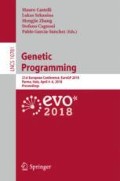Abstract
Rule-based graph programming is a deep and rich topic. We present an approach to exploiting the power of graph programming as a representation and as an execution medium in an evolutionary algorithm (EGGP). We demonstrate this power in comparison with Cartesian Genetic Programming (CGP), showing that it is significantly more efficient in terms of fitness evaluations on some classic benchmark problems. We hypothesise that this is due to its ability to exploit the full graph structure, leading to a richer mutation set, and outline future work to test this hypothesis, and to exploit further the power of graph programming within an EA.
T. Atkinson—Supported by a Doctoral Training Grant from the Engineering and Physical Sciences Research Council (EPSRC) in the UK.
Access this chapter
Tax calculation will be finalised at checkout
Purchases are for personal use only
References
Atkinson, T., Plump, D., Stepney, S.: Probabilistic graph programming. In: Proceedings of the International Workshop on Graph Computation Models (GCM 2017) (2017)
Bak, C., Plump, D.: Compiling graph programs to C. In: Echahed, R., Minas, M. (eds.) ICGT 2016. LNCS, vol. 9761, pp. 102–117. Springer, Cham (2016). https://doi.org/10.1007/978-3-319-40530-8_7
Coecke, B., Duncan, R.: Interacting quantum observables: categorical algebra and diagrammatics. New J. Phys. 13(4) (2011). 86 p
Cormen, T.H., Leiserson, C.E., Rivest, R.L., Stein, C.: Introduction to Algorithms, 3rd edn. MIT Press, Cambridge (2009)
Jungnickel, D.: Graphs, Networks and Algorithms, 4th edn. Springer, Heidelberg (2013). https://doi.org/10.1007/978-3-642-32278-5
Koza, J.R.: Genetic Programming: On the Programming of Computers by Means of Natural Selection. MIT Press, Cambridge (1993)
Koza, J.R., Bennett, F.H., Stiffelman, O.: Genetic programming as a Darwinian invention machine. In: Poli, R., Nordin, P., Langdon, W.B., Fogarty, T.C. (eds.) EuroGP 1999. LNCS, vol. 1598, pp. 93–108. Springer, Heidelberg (1999). https://doi.org/10.1007/3-540-48885-5_8
Galván-López, E., Rodríguez-Vázquez, K.: Multiple interactive outputs in a single tree: an empirical investigation. In: Ebner, M., O’Neill, M., Ekárt, A., Vanneschi, L., Esparcia-Alcázar, A.I. (eds.) EuroGP 2007. LNCS, vol. 4445, pp. 341–350. Springer, Heidelberg (2007). https://doi.org/10.1007/978-3-540-71605-1_32
Machado, P., Correia, J., Assunção, F.: Graph-based evolutionary art. In: Gandomi, A.H., Alavi, A.H., Ryan, C. (eds.) Handbook of Genetic Programming Applications, pp. 3–36. Springer, Cham (2015). https://doi.org/10.1007/978-3-319-20883-1_1
Mann, H.B., Whitney, D.R.: On a test of whether one of two random variables is stochastically larger than the other. Ann. Math. Statist. 18(1), 50–60 (1947)
Mano, M.M.: Digital Design. EBSCO Publishing Inc., Ipswich (2002)
Miller, J.F.: Cartesian Genetic Programming. Springer, Heidelberg (2011). https://doi.org/10.1007/978-3-642-17310-3
Miller, J.F., Smith, S.L.: Redundancy and computational efficiency in Cartesian Genetic Programming. IEEE Trans. Evol. Comput. 10(2), 167–174 (2006)
Miller, J.F., Thomson, P.: Cartesian genetic programming. In: Poli, R., Banzhaf, W., Langdon, W.B., Miller, J., Nordin, P., Fogarty, T.C. (eds.) EuroGP 2000. LNCS, vol. 1802, pp. 121–132. Springer, Heidelberg (2000). https://doi.org/10.1007/978-3-540-46239-2_9
O’Neill, M., Ryan, C.: Grammatical evolution. IEEE Trans. Evol. Comput. 5(4), 349–358 (2001)
Pereira, F.B., Machado, P., Costa, E., Cardoso, A.: Graph based crossover - a case study with the busy beaver problem. In: Proceedings of the Annual Conference on Genetic and Evolutionary Computation (GECCO), pp. 1149–1155. Morgan Kaufmann (1999)
Plump, D.: The design of GP 2. In: Proceedings of the Workshop on Reduction Strategies in Rewriting and Programming (WRS 2011), EPTCS, vol. 82, pp. 1–16 (2012). https://doi.org/10.4204/EPTCS.82.1
Plump, D.: From imperative to rule-based graph programs. J. Logical Algebraic Methods Program. 88, 154–173 (2017). https://doi.org/10.1016/j.jlamp.2016.12.001
Poli, R.: Evolution of graph-like programs with parallel distributed genetic programming. In: Bäck, T. (ed.) Proceedings of the International Conference on Genetic Algorithms, pp. 346–353. Morgan Kaufmann (1997)
Poli, R.: Parallel distributed genetic programming. In: Corne, D., Dorigo, M., Glover, F. (eds.) New Ideas in Optimization, pp. 403–431. McGraw-Hill (1999)
Ryan, C., Collins, J.J., Neill, M.O.: Grammatical evolution: evolving programs for an arbitrary language. In: Banzhaf, W., Poli, R., Schoenauer, M., Fogarty, T.C. (eds.) EuroGP 1998. LNCS, vol. 1391, pp. 83–96. Springer, Heidelberg (1998). https://doi.org/10.1007/BFb0055930
Skiena, S.S.: The Algorithm Design Manual, 2nd edn. Springer, London (2008). https://doi.org/10.1007/978-1-84800-070-4
Stanley, K.O., Miikkulainen, R.: Efficient reinforcement learning through evolving neural network topologies. In: Proceedings of the Annual Conference on Genetic and Evolutionary Computation (GECCO), pp. 569–577. Morgan Kaufmann Publishers Inc. (2002)
Stanley, K.O., Miikkulainen, R.: Evolving neural networks through augmenting topologies. Evol. Comput. 10(2), 99–127 (2002)
Syvanen, M., Kado, C.I.: Horizontal Gene Transfer. Academic Press, London (2001)
Turner, A.J., Miller, J.F.: Introducing a cross platform open source Cartesian Genetic Programming library. Genet. Program Evolvable Mach. 16(1), 83–91 (2015)
Vargha, A., Delaney, H.D.: A critique and improvement of the CL common language effect size statistics of McGraw and Wong. J. Educ. Behav. Stat. 25(2), 101–132 (2000)
Walker, J.A., Miller, J.F.: Evolution and acquisition of modules in Cartesian Genetic Programming. In: Keijzer, M., O’Reilly, U.-M., Lucas, S., Costa, E., Soule, T. (eds.) EuroGP 2004. LNCS, vol. 3003, pp. 187–197. Springer, Heidelberg (2004). https://doi.org/10.1007/978-3-540-24650-3_17
Author information
Authors and Affiliations
Corresponding author
Editor information
Editors and Affiliations
Rights and permissions
Copyright information
© 2018 Springer International Publishing AG, part of Springer Nature
About this paper
Cite this paper
Atkinson, T., Plump, D., Stepney, S. (2018). Evolving Graphs by Graph Programming. In: Castelli, M., Sekanina, L., Zhang, M., Cagnoni, S., García-Sánchez, P. (eds) Genetic Programming. EuroGP 2018. Lecture Notes in Computer Science(), vol 10781. Springer, Cham. https://doi.org/10.1007/978-3-319-77553-1_3
Download citation
DOI: https://doi.org/10.1007/978-3-319-77553-1_3
Published:
Publisher Name: Springer, Cham
Print ISBN: 978-3-319-77552-4
Online ISBN: 978-3-319-77553-1
eBook Packages: Computer ScienceComputer Science (R0)

